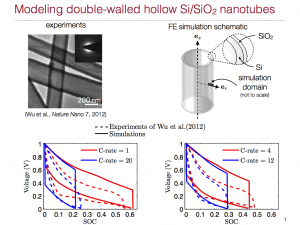Overview
In this work we formulate and numerically implement a fully-coupled diffusion-deformation theory for amorphous Silicon anodes. The theory accounts for transient diffusion of lithium and accompanying large elastic-plastic deformations. The material parameters in the theory have been calibrated to experiments of galvanostatic cycling of half-cells composed of an a-Si thin-film anode deposited on a quartz substrate, which have been reported on the literature.
We have applied our numerical simulation capability to model galvanostatic charging of hollow a-Si nanotubes whose exterior walls have been oxidized to prevent outward expansion. We show that the results from our numerical simulations are in good agreement with the experimentally-measured voltage vs. SOC behavior at various charging rates (see figure below).
Through our simulations, we identify and quantify two major effects of plasticity on the electrochemical performance of these a-Si anodes:
– For a given voltage cut-off, plasticity enables lithiation of the anode to a higher SOC by reducing the stresses generated in the materials.
– Plastic deformation can account for a significant percentage of the energy dissipated during the cycling of the anode.
Publications
Di Leo, C.V., Rejovitzky, E., Anand, L., (2015). Diffusion-deformation theory for amorphous silicon anodes: the role of plastic deformation on electrochemical performance. International Journal of Solids and Structures 67-68, 283-296. [html]
Rejovitzky, E., Di Leo, C.V., Anand, L., (2015). A theory and a simulation capability for the growth of a solid electrolyte interphase layer at an anode particle in a Li-ion battery. Journal of the Mechanics and Physics of Solids 78, 210-230. [html]
Di Leo, C.V., (2015). Chemo-Mechanics of Lithium-Ion Battery Electrodes. Ph.D. Diss., Massachsetts Institute of Technology. [html]
Media

Back to Research

